Regional Differences and Convergence of Inter-Provincial Green Total Factor Productivity in China under Technological Heterogeneity
Abstract
:1. Introduction
2. Methodology and Data
2.1. SBM-DEA Model
2.2. Common and Group Frontiers
2.3. Technological Gap Ratio
2.4. GML Index
2.5. Selection of Indicators and Data Processing
2.5.1. Indicators for GTFP Measurement
2.5.2. GTFP Impact Indicators
3. Analysis of Inter-Provincial GTFP Measurement in China
3.1. Data Sources and Descriptive Statistics
3.2. Comparative Analysis of China’s Inter-Provincial Green Development Efficiency under Meta-Frontier and Group Frontier
3.3. Characteristics of the Changing Spatial Distribution Pattern of GTFP between Provinces in China under the Group Frontier
3.3.1. Evolution of the Spatial Pattern of Inter-Provincial GTFP in China
3.3.2. Inter-Provincial GTFP Gravity Center Shifts Path in China
3.3.3. Standard Deviational Ellipsoid Analysis of Inter-Provincial GTFP in China
3.4. Inter-Provincial GTFP Convergence Analysis in China under Group Frontier
3.4.1. The σ Convergence Test
3.4.2. Absolute β Convergence Test
3.4.3. Conditional β Convergence Test
4. Conclusions and Policy Implications
- China’s inter-provincial green development efficiency varied significantly under the group frontier and meta-frontier. Under the meta-frontier, the mean values of green development efficiency during 2001–2017 were eastern region > central region > western region, while under the group frontier, the mean values were central region > western region > eastern region. Based on the technological gap ratio, the eastern region was closer to the meta-frontier in terms of green development efficiency technology, while the western and central regions were far away from the meta-frontier. This shows that the green development efficiency is preferable under the group frontier. Moreover, it also indicates the rationality and necessity of analyzing according to the three major groups.
- China’s inter-provincial GTFP was measured based on the group frontier. The average value of GTFP in 30 provinces (municipalities and autonomous regions) was 1.043, and GTFP gradually increased. From a regional perspective, the three major regions of China showed large differences, with the western region maintaining the same trend as the whole country, the eastern region having a relatively stable development of GTFP as a whole, and the central region having an apparent upward trend of GTFP.
- During the study period, the GTFP of 30 provinces (municipalities and autonomous regions) in China was relatively spatially stable, with the center of gravity shifting in the southwest–northeast direction. The range of the standard deviational ellipse showed a gradual decrease trend at each characteristic time point, indicating that the spatial distribution pattern of GTFP among Chinese provinces tended to be concentrated and relatively stable.
- From the convergence test results, σ convergence existed only in China’s western region, and absolute β convergence and conditional β convergence were present in the whole country and in the eastern, central, and western regions. In terms of influencing factors, industrial structure and fiscal concentration had significant integrity. The industrial structure had a significant impact on the improvement of GTFP in the eastern region. Moreover, it is necessary for the central and western regions to accelerate the degree of market opening and the share of natural gas consumption, to enhance GTFP further.
- It is crucial to improve and develop the market-based environmental regulation system and it is necessary to solve the prominent problems in the trading of emission rights, carbon emissions, and water rights. In addition, it is also necessary to break down administrative divisions, scientifically allocate the total amount of pollutants in the region, and formulate corresponding incentives and penalties. Furthermore, different regions should accelerate the implementation of paid use system of resources, optimize the industrial structure through rationalizing environmental regulation policies, and thus promote the development of green industries.
- It is essential to implement an innovation-driven strategy to enhance the value creation of factor resources, optimize factor allocation, and transform the mode of economic development. In addition, we can promote the effective flow of innovative factors and resources, adhere to scientific and technological innovation and institutional innovation, give full play to the advantages of dense innovative resources, and form an innovative agglomeration effect. It is also crucial to promote the development of a circular low-carbon economy by strengthening green technological innovation (green roofs, green facades, and carbon neutralization technology, etc.), promoting the concept of green ecological civilization, and achieving a win–win development model of environmental protection and economic growth.
- It is necessary to implement regionally differentiated environmental regulation policies. The government should increase the ability to enhance green technology innovation in the central and western regions, establish a sound science and technology innovation system, and enhance the overall intensification of green resources within and between regions. It is also important for the government to build a regional joint prevention mechanism, promote joint innovation between regional industries, universities, and research institutes, protect the environment according to local conditions, and form a joint force to control pollution emissions. In this way, coordinated and green development can be promoted in cities located in different economic circles.
- The legalization of environmental management and public participation in environmental protection needs to be strengthened. It is important to actively carry out various educational and publicity activities and promote energy-saving and emission-reducing consumption patterns and lifestyles. The work of education on the concept of ecological civilization requires the organic integration of the government, society, and schools. In addition, the government should improve the social supervision system, increase the transparency of public information, introduce the public supervision mechanism into the trading system of carbon emission rights and emission rights, and make public the trading information through various media such as newspapers, television, and the Internet to accept public supervision.
- It is important to create a good macro policy and market environment, create a good institutional environment for green technology innovation, form an institutional mechanism conducive to the optimal allocation of science and technology resources, and realize the positive promotion effect of optimizing the system’s quality and improving GTFP. The government should promote its governance system and capacity, break down institutional barriers, and increase the value of factor resources for creativity. In this way, the economic construction and environmental protection can be mutually compatible to comprehensively increase China’s inter-provincial GTFP and promote China’s high-quality economic development.
Author Contributions
Funding
Institutional Review Board Statement
Informed Consent Statement
Data Availability Statement
Acknowledgments
Conflicts of Interest
References
- Solow, R.M. Technical Change and the Aggregate Production Function. Rev. Econ. Stat. 1957, 39, 312. [Google Scholar] [CrossRef] [Green Version]
- Farrell, M.J. The Measurement of Productive Efficiency. J. R. Stat. Soc. 1957, 120, 253–290. [Google Scholar] [CrossRef]
- Charnes, A.; Cooper, W.W.; Rhodes, E. Measuring the efficiency of decision making units. Eur. J. Oper. Res. 1978, 2, 429–444. [Google Scholar] [CrossRef]
- Chung, Y.H.; Färe, R.; Grosskopf, S. Productivity and Undesirable Outputs: A Directional Distance Function Approach. J. Environ. Manag. 1997, 51, 229–240. [Google Scholar] [CrossRef] [Green Version]
- Dettori, B.; Marrocu, E.; Paci, R. Total Factor Productivity, Intangible Assets and Spatial Dependence in the European Regions. Reg. Stud. 2012, 46, 1401–1416. [Google Scholar] [CrossRef] [Green Version]
- Moghaddasi, R.; Pour, A.A. Energy consumption and total factor productivity growth in Iranian agriculture. Energy Rep. 2017, 2, 218–220. [Google Scholar] [CrossRef] [Green Version]
- Coomes, O.T.; Barham, B.L.; MacDonald, G.K.; Ramankutty, N.; Chavas, J.-P. Leveraging total factor productivity growth for sustainable and resilient farming. Nat. Sustain. 2019, 2, 22–28. [Google Scholar] [CrossRef] [Green Version]
- Shair, F.; Shaorong, S.; Kamran, H.W.; Hussain, M.S.; Nawaz, M.A.; Nguyen, V.C. Assessing the efficiency and total factor productivity growth of the banking industry: Do environmental concerns matters? Environ. Sci. Pollut. Res. 2021, 28, 20822–20838. [Google Scholar] [CrossRef]
- Yang, Z.; Fan, M.; Shao, S.; Yang, L. Does carbon intensity constraint policy improve industrial green production performance in China? A quasi-DID analysis. Energy Econ. 2017, 68, 271–282. [Google Scholar] [CrossRef]
- Hou, B.; Wang, B.; Du, M.; Zhang, N. Does the SO2 emissions trading scheme encourage green total factor productivity? Anempirical assessment on China’s cities. Environ. Sci. Pollut. Res. 2019, 27, 6375–6388. [Google Scholar] [CrossRef]
- Huang, C.; Yin, K.; Liu, Z.; Cao, T. Spatial and Temporal Differences in the Green Efficiency of Water Resources in the Yangtze River Economic Belt and Their Influencing Factors. Int. J. Environ. Res. Public Health 2021, 18, 3101. [Google Scholar] [CrossRef]
- Chen, S.Y.; Golley, J. ‘Green’ productivity growth in China’s industrial economy. Energy Econ. 2014, 44, 89–98. [Google Scholar] [CrossRef]
- Dong, G.; Wang, Z.; Mao, X. Production efficiency and GHG emissions reduction potential evaluation in the crop production system based on emergy synthesis and nonseparable undesirable output DEA: A case study in Zhejiang Province, China. PLoS ONE 2018, 13, e0206680. [Google Scholar] [CrossRef] [PubMed]
- Le, T.L.; Lee, P.-P.; Peng, K.C.; Chung, R.H. Evaluation of total factor productivity and environmental efficiency of agriculture in nine East Asian countries. Agric. Econ. Czech 2019, 65, 249–258. [Google Scholar] [CrossRef]
- Umetsu, C.; Lekprichakul, T.; Chakravorty, U. Efficiency and Technical Change in the Philippine Rice Sector: A Malmquist Total Factor Productivity Analysis. Am. J. Agric. Econ. 2003, 85, 943–963. [Google Scholar] [CrossRef]
- Wang, X.; Sun, C.; Wang, S.; Zhang, Z.; Zou, W. Going Green or Going Away? A Spatial Empirical Examination of the Relationship between Environmental Regulations, Biased Technological Progress, and Green Total Factor Productivity. Int. J. Environ. Res. Public Health 2018, 15, 1917. [Google Scholar] [CrossRef] [Green Version]
- Ahmed, E.M. Modelling green productivity spillover effects on sustainability. World J. Sci. Technol. Sustain. Dev. 2020, 17, 257–267. [Google Scholar] [CrossRef]
- Xu, X.; Huang, X.; Huang, J.; Gao, X.; Chen, L. Spatial-Temporal Characteristics of Agriculture Green Total Factor Productivity in China, 1998–2016: Based on More Sophisticated Calculations of Carbon Emissions. Int. J. Environ. Res. Public Health 2019, 16, 3932. [Google Scholar] [CrossRef] [Green Version]
- Ahmed, E.M. Green TFP Intensity Impact on Sustainable East Asian Productivity Growth. Econ. Anal. Policy 2012, 42, 67–78. [Google Scholar] [CrossRef]
- Shen, Z.; Boussemart, J.-P.; Leleu, H. Aggregate green productivity growth in OECD’s countries. Int. J. Prod. Econ. 2017, 189, 30–39. [Google Scholar] [CrossRef] [Green Version]
- Loganathan, N.; Mursitama, T.N.; Pillai, L.L.K.; Khan, A.; Taha, R. The effects of total factor of productivity, natural resources and green taxation on CO(2)emissions in Malaysia. Environ. Sci. Pollut. Res. 2020, 27, 45121–45132. [Google Scholar] [CrossRef] [PubMed]
- Fang, L.; Hu, R.; Mao, H.; Chen, S. How crop insurance influences agricultural green total factor productivity: Evidence from Chinese farmers. J. Clean. Prod. 2021, 321, 128977. [Google Scholar] [CrossRef]
- Zhang, J.X.; Lu, G.Y.; Skitmore, M.; Ballesteros-Perez, P. A critical review of the current research mainstreams and the influencing factors of green total factor productivity. Environ. Sci. Pollut. Res. 2021, 28, 35392–35405. [Google Scholar] [CrossRef] [PubMed]
- Jiang, Y.Q. Total Factor Production, Pollution and ‘Green’ Economic Growth in China. J. Int. Dev. 2015, 27, 504–515. [Google Scholar] [CrossRef]
- Shao, S.A.; Luan, R.R.; Yang, Z.B.; Li, C.Y. Does directed technological change get greener: Empirical evidence from Shang-hai’s industrial green development transformation. Ecol. Indic. 2016, 69, 758–770. [Google Scholar] [CrossRef]
- Lei, X.; Wu, S. Nonlinear Effects of Governmental and Civil Environmental Regulation on Green Total Factor Productivity in China. Adv. Meteorol. 2019, 2019, 8351512. [Google Scholar] [CrossRef]
- Li, H.; Li, B. The threshold effect of environmental regulation on the green transition of the industrial economy in China. Econ. Res.-Ekon. Istraz. 2019, 32, 3134–3149. [Google Scholar] [CrossRef] [Green Version]
- Feng, Y.C.; Wang, X.H.; Feng, S.L. FDI, OFDI and China’s green Total Factor Productivity—An analysis based on spatial econometric model. China Manag. Sci. 2021, 29, 81–91. [Google Scholar]
- Zhou, X.H.; Liu, Y.Y.; Peng, L.Y. Development of digital economy and improvement of green total factor productivity. Shanghai Econ. Res. 2021, 12, 51–63. [Google Scholar]
- Khan, S.A.R.; Zhang, Y.; Umar, M. A road map for environmental sustainability and green economic development: An empirical study. Environ. Sci. Pollut. Res. 2021, 29, 16082–16090. [Google Scholar] [CrossRef]
- Zhao, Y.R. Green total factor productivity improvement and technological innovation in logistics industry—An Empirical Test Based on sys-gmm method. Bus. Econ. Res. 2022, 6, 115–118. [Google Scholar]
- Li, B.; Qin, H.; Sun, W. The interactive relationship between industrial transformation and upgrading and the improvement of green Total Factor Productivity—An Empirical Study Based on 116 prefecture level resource-based cities in China. J. Nat. Resour. 2022, 37, 186–199. [Google Scholar]
- Coelli, T.J.; Rao, D.S.P. Total factor productivity growth in agriculture: A Malmquist index analysis of 93 countries, 1980–2000. Agric. Econ. 2005, 32, 115–134. [Google Scholar] [CrossRef] [Green Version]
- Huang, Z.; Fu, Y.; Liang, Q.; Song, Y.; Xu, X. The Efficiency of Agricultural Marketing Cooperatives in China’s Zhejiang Province. Manag. Decis. Econ. 2013, 34, 272–282. [Google Scholar] [CrossRef]
- Li, J.; Xu, J.T. Analysis of Inter-provincial Green Total Factor Productivity Growth Trends-An Application of a Non-Parametric Method. J. Beijing For. Univ. (Soc. Sci. Ed.) 2009, 8, 139–146. [Google Scholar]
- Chen, S.Y. Energy Consumption, Carbon Dioxide Emissions, and the Sustainable Development of Chinese industry. Econ. Res. 2009, 44, 41–55. [Google Scholar]
- Li, B.; Peng, X.; Ouyang, M.K. Environmental Regulation, Green Total Factor Productivity and the Transformation of China’s Industrial Development—An Empirical Study Based on Data from 36 Industrial Sectors. China Ind. Econ. 2013, 4, 56–68. [Google Scholar]
- Chen, Y.; Zhang, J. Carbon Emissions, Green Total Factor Productivity and Economic Growth. Quant. Econ. Tech. Econ. Res. 2016, 33, 47–63. [Google Scholar]
- Li, J.; Xu, B. “Curse” or “Gospel”: How Does Resource Abundance Affect China’s Green Economic Growth? J. Econ. Res. 2018, 53, 151–167. [Google Scholar]
- Wang, Y.; Li, H.Y.; Yu, H. Spatial Pattern of Provincial Green Development and Its Evolutionary Characteristics in China. China Popul.-Resour. Environ. 2018, 28, 96–104. [Google Scholar]
- Li, J.; Liu, Z. Spatial Differences in Green Total Factor Productivity and Influencing Factors in Three Major Urban Clusters in China. Soft Sci. 2019, 33, 61–64+80. [Google Scholar]
- Amani, N.; Valami, H.B.; Ebrahimnejad, A. Application of Malmquist productivity index with carry-overs in power industry. Alex. Eng. J. 2019, 57, 3151–3165. [Google Scholar] [CrossRef]
- Baležentis, T.; Blancard, S.; Shen, Z.; Štreimikienė, D. Analysis of Environmental Total Factor Productivity Evolution in European Agricultural Sector. Decis. Sci. 2020, 52, 483–511. [Google Scholar] [CrossRef]
- Teng, Z.W. Study on the Spatial Divergence and Drivers of Green Total Factor Productivity in China’s Service Industry. J. Quant. Tech. Econ. 2020, 37, 23–41. [Google Scholar]
- Wu, L.; Jia, X.Y.; Wu, C.; Peng, J.C. Impact of Heterogeneous Environmental Regulations on Green Total Factor Productivity in China. China Popul. Resour. Environ. 2020, 30, 82–92. [Google Scholar]
- Lin, P.; Meng, N.N. Quality Measurement and Dynamics Deconstruction of Regional Economic Development in Beijing-Tianjin-Hebei under Environmental Constraints—Based on Green Total Factor Productivity Perspective. Econ. Geogr. 2020, 40, 36–45. [Google Scholar]
- Li, T.; Han, D.; Ding, Y.; Shi, Z. How Does the Development of the Internet Affect Green Total Factor Productivity? Evidence from China. IEEE Access 2021, 8, 216477–216490. [Google Scholar] [CrossRef]
- Song, M.L.; Peng, L.C.; Shang, Y.P.; Zhao, X. Green technology progress and total factor productivity of resource-based enterprises: A perspective of technical compensation of environmental regulation. Technol. Forecast. Soc. Change 2022, 174, 121276. [Google Scholar] [CrossRef]
- Tone, K. A slacks-based measure of efficiency in data envelopment analysis. Eur. J. Oper. Res. 2001, 130, 498–509. [Google Scholar] [CrossRef] [Green Version]
- Battese, G.E.; Rao, D.S.P.; O’Donnell, C.J. A Metafrontier Production Function for Estimation of Technical Efficiencies and Technology Gaps for Firms Operating Under Different Technologies. J. Product. Anal. 2004, 21, 91–103. [Google Scholar] [CrossRef]
- Oh, D.-H. A global Malmquist-Luenberger productivity index. J. Prod. Anal. 2010, 34, 183–197. [Google Scholar] [CrossRef]
- Zhang, J.; Wu, G.; Zhang, J. Estimation of Interprovincial Physical Capital Stock in China: 1952–2000. Econ. Res. 2004, 10, 35–44. [Google Scholar]
- Shan, H.J. Re estimation of China’s capital stock K: 1952 ~ 2006. J. Quant. Tech. Econ. 2008, 25, 17–31. [Google Scholar]
- Liu, X.G.; Gong, B.L. New growth analysis framework, TFP measurement and driving factors for high-quality development. Economics 2022, 22, 613–632. [Google Scholar]
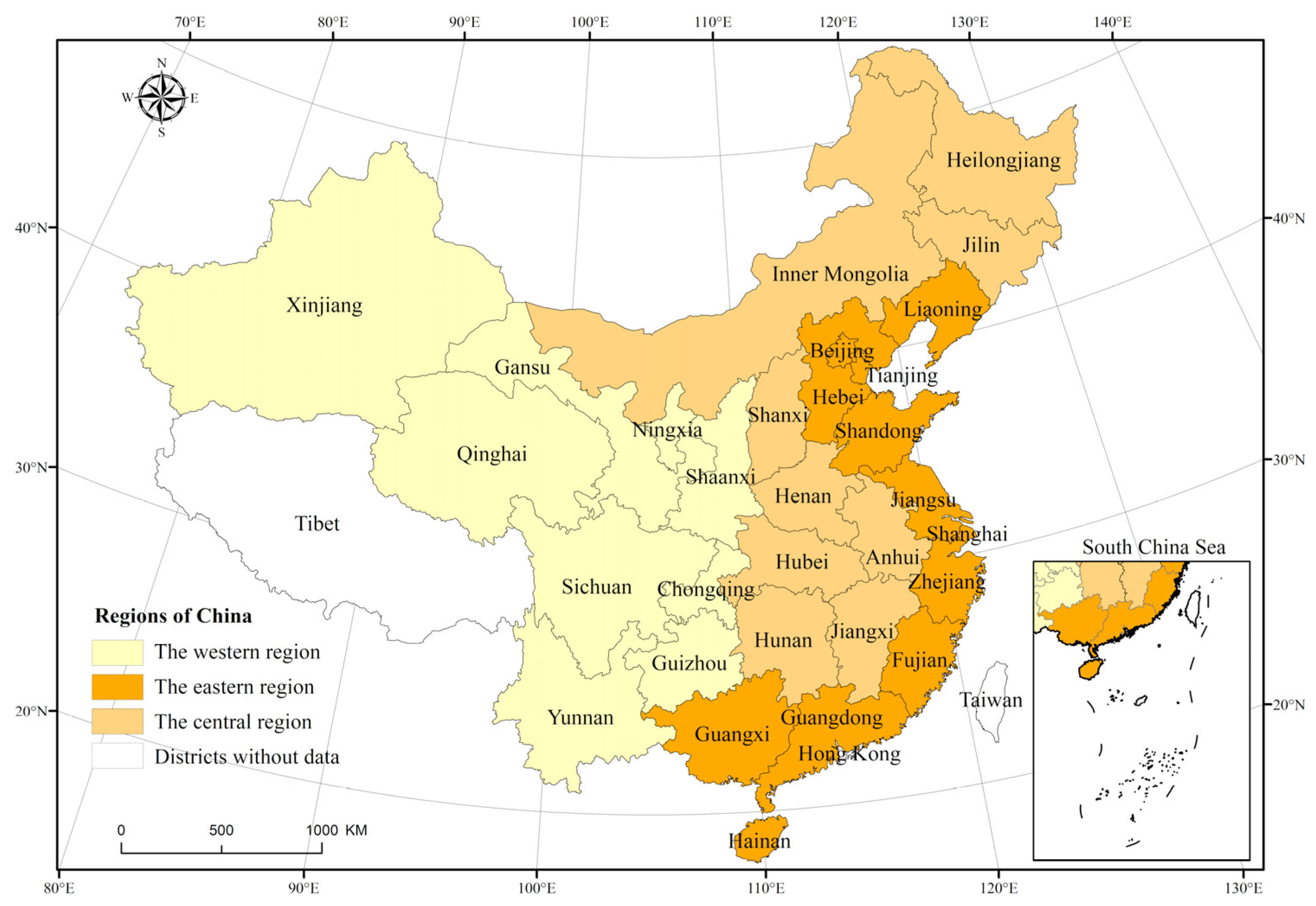
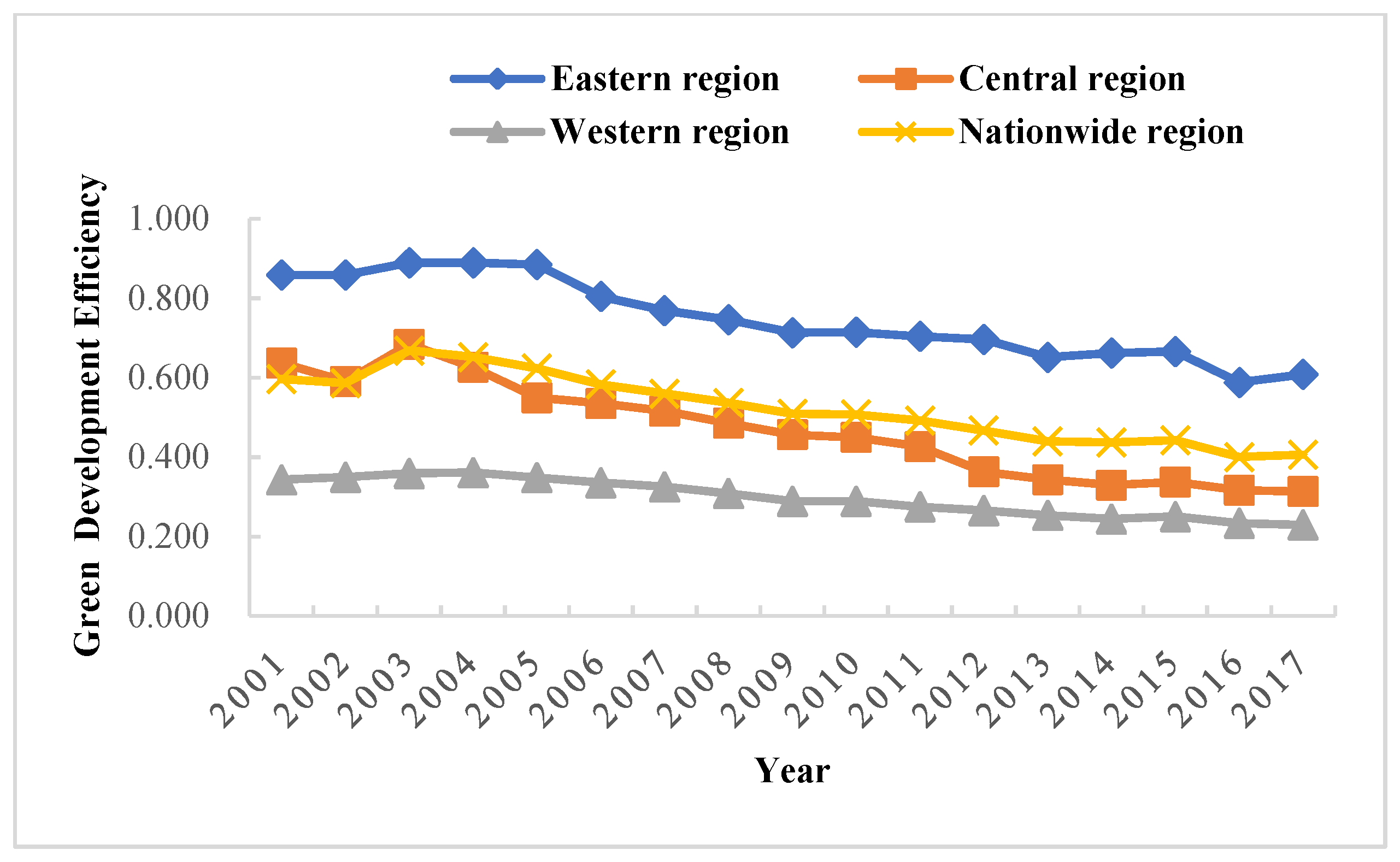
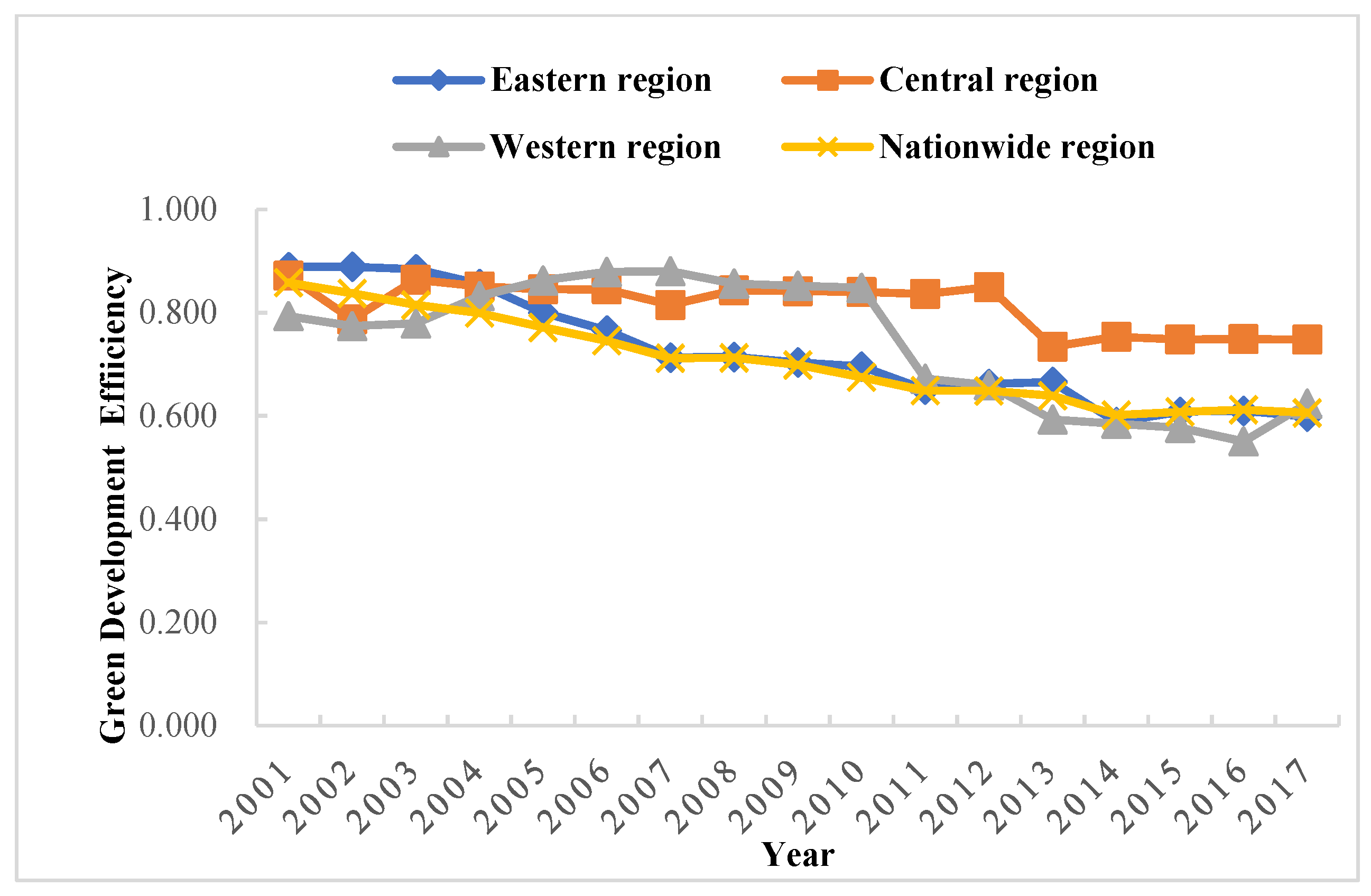
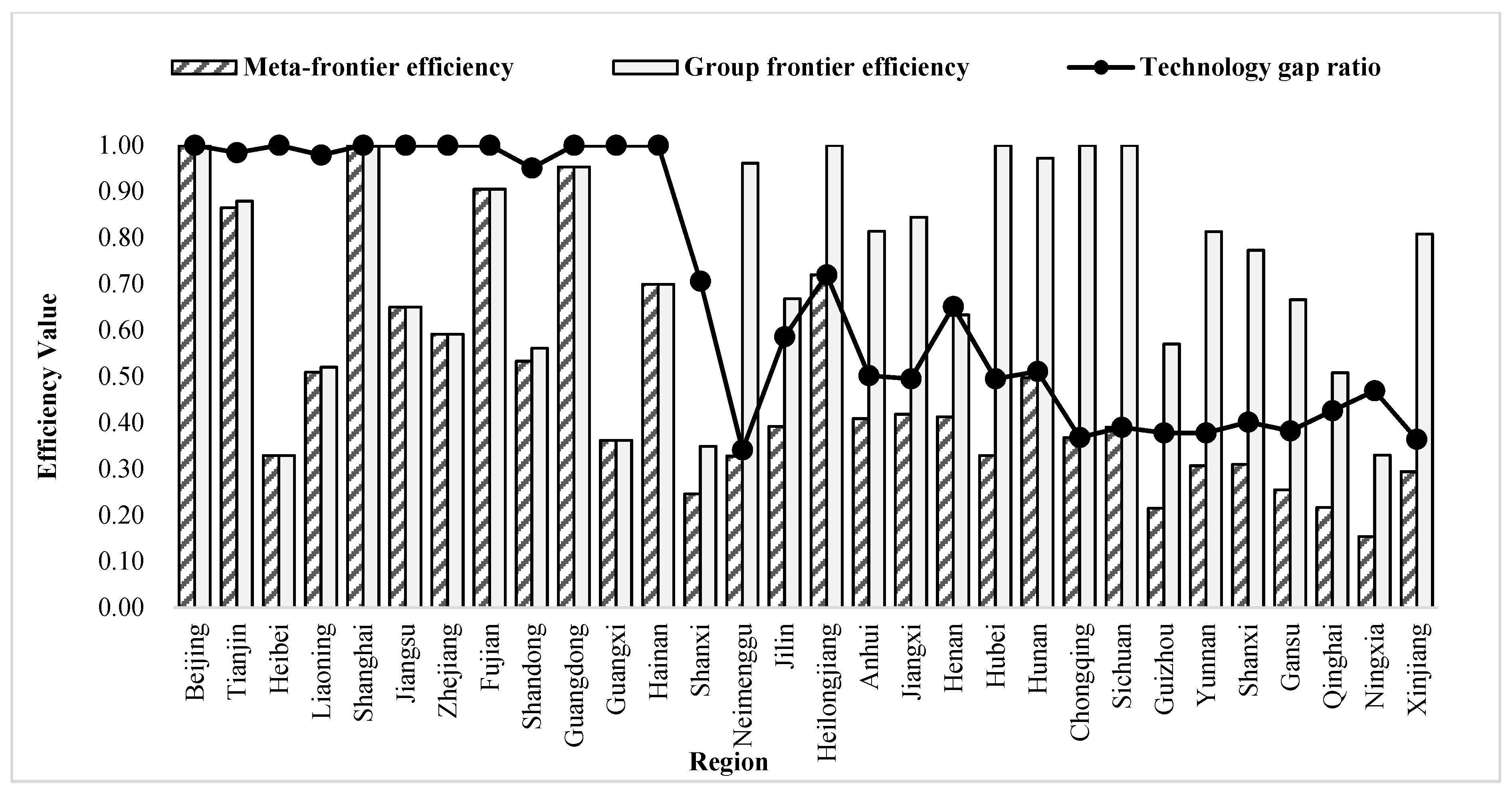
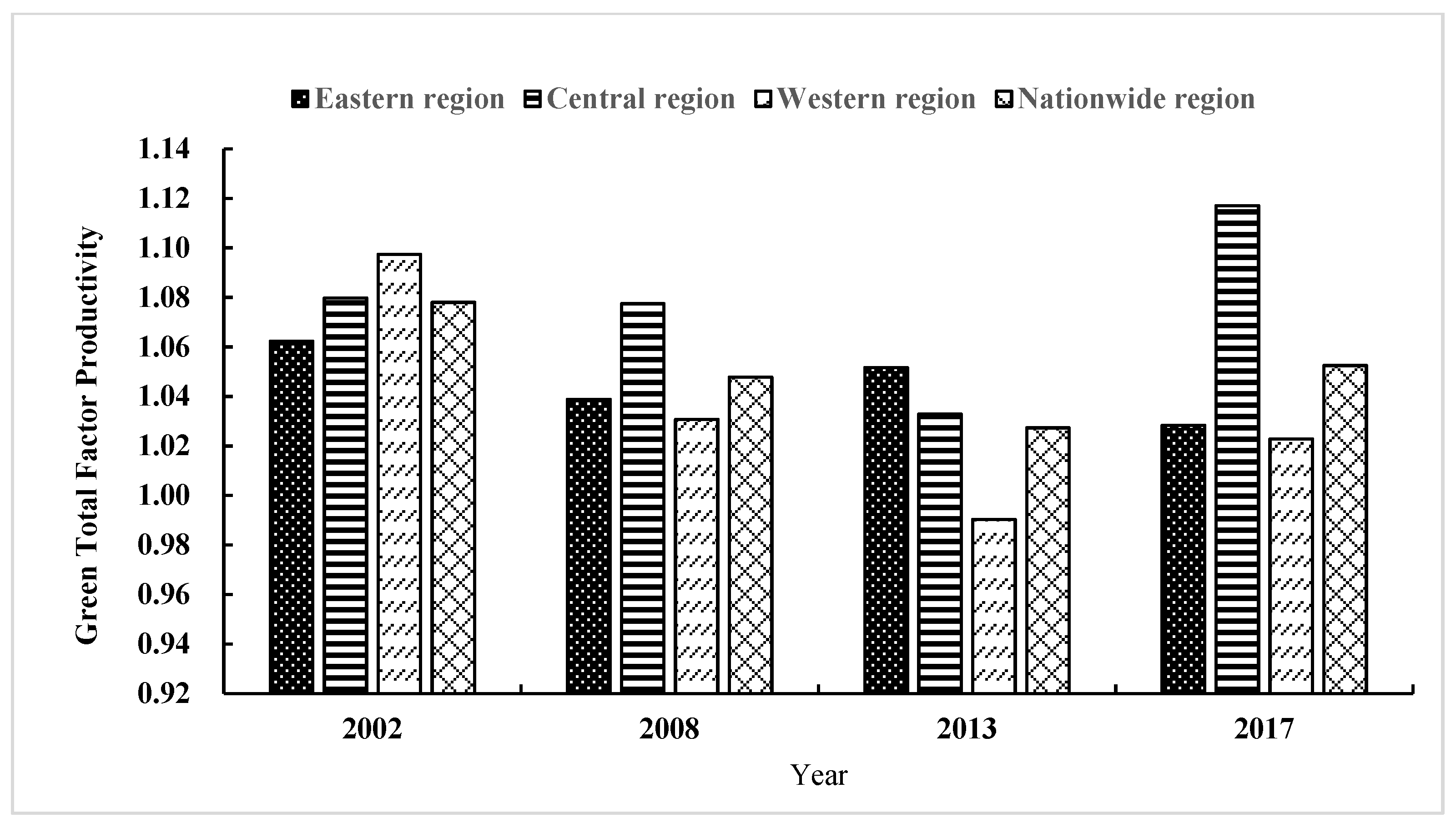
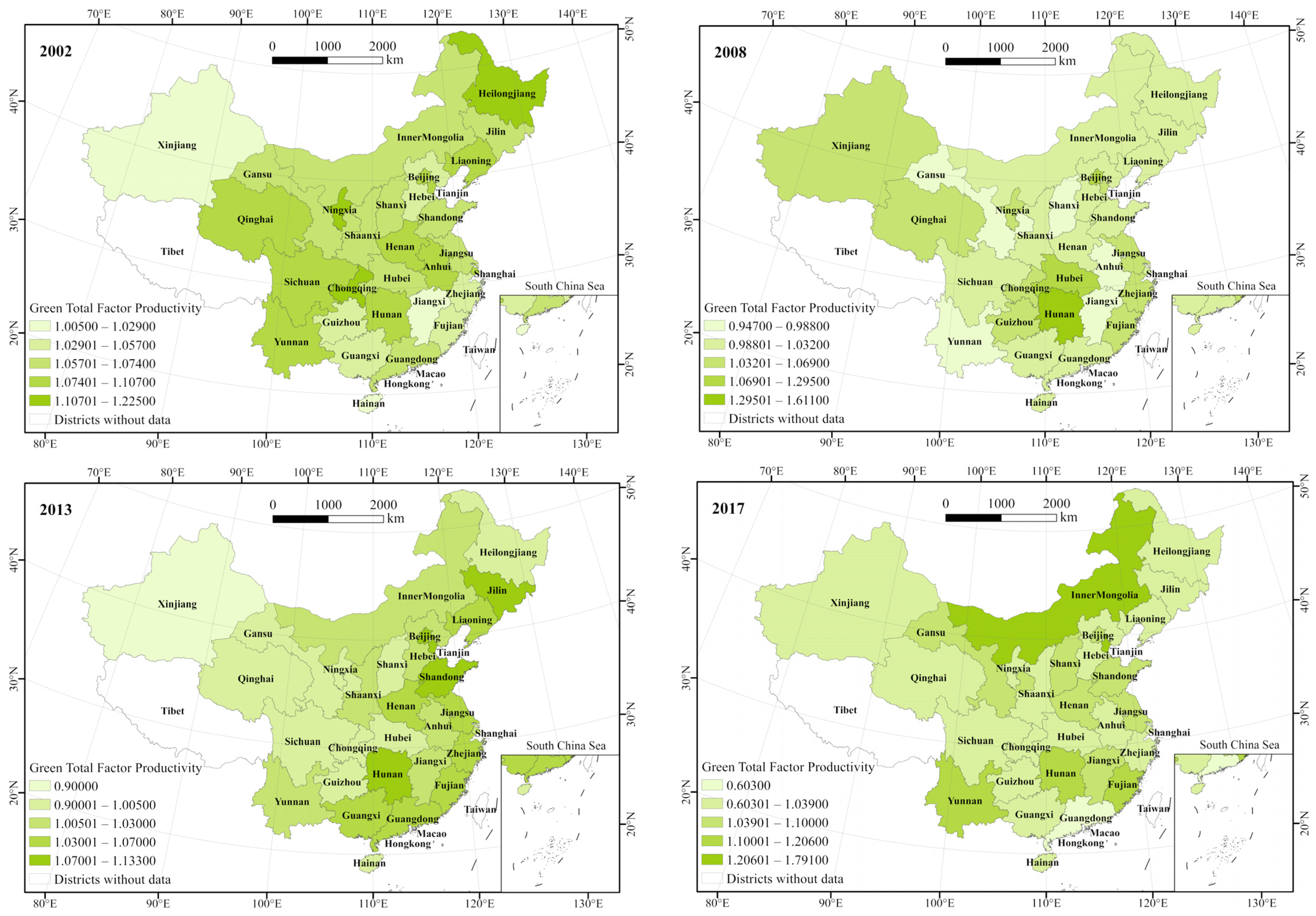
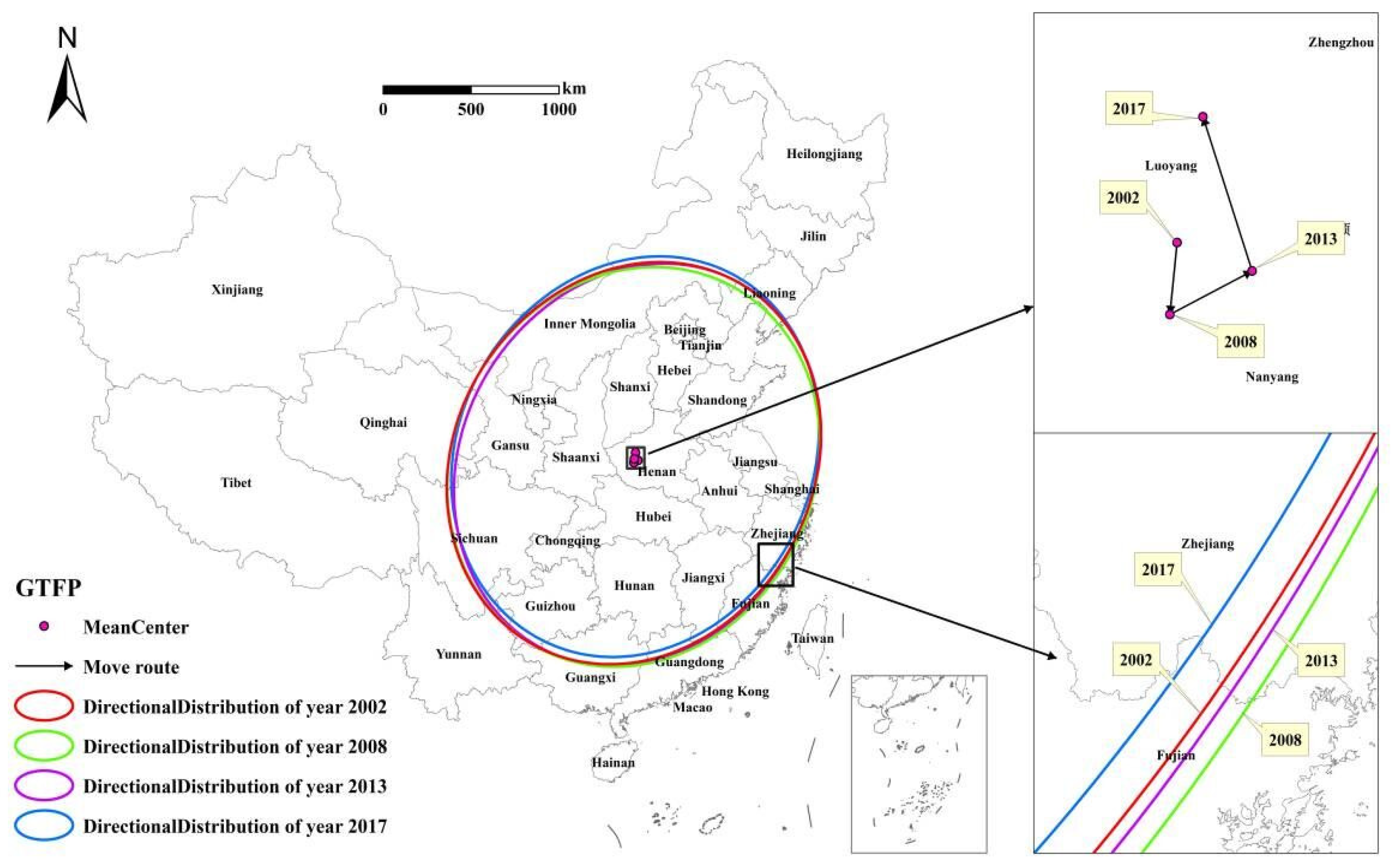
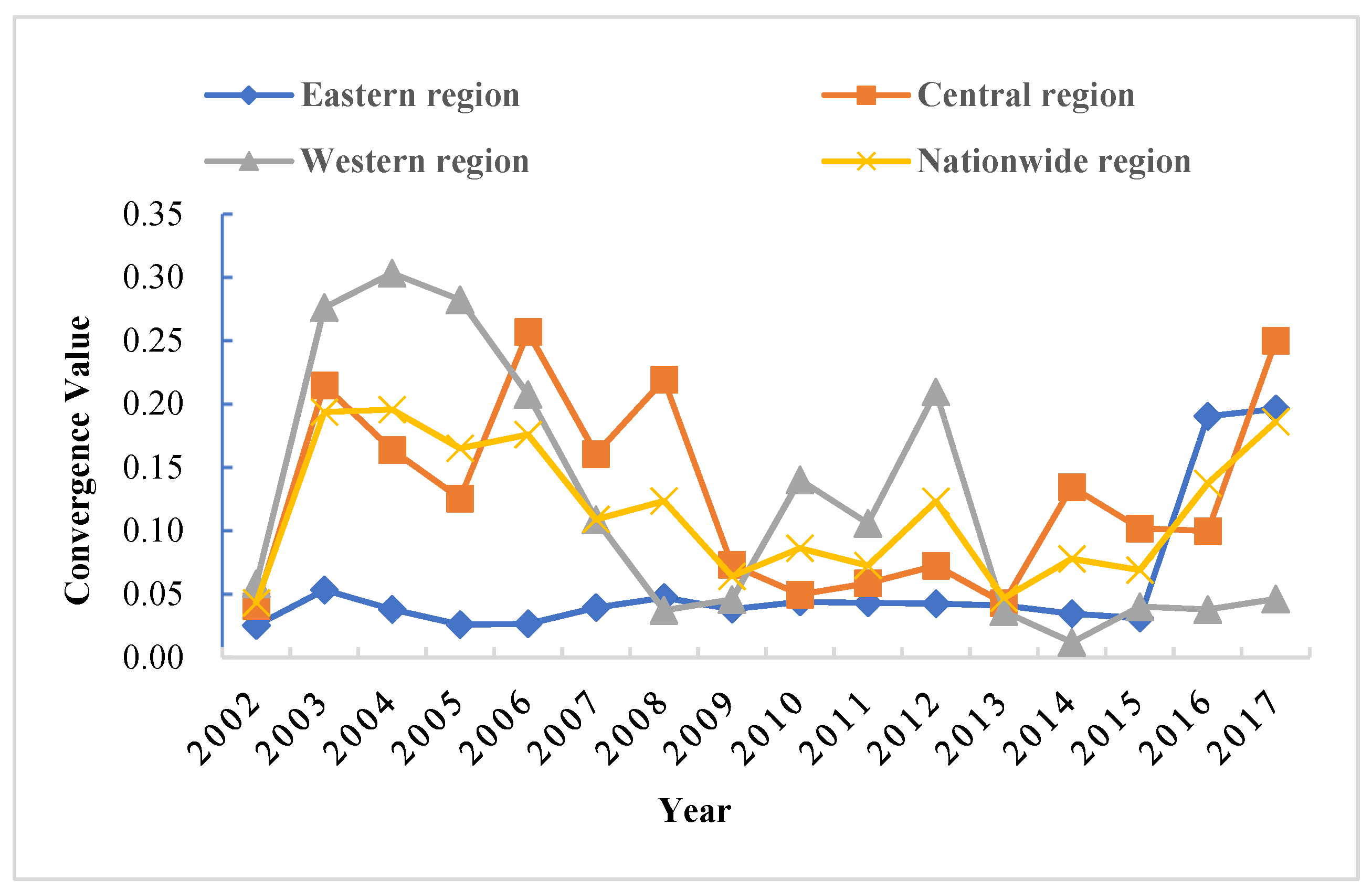
| Targets | Unit | Minimum Value | Maximum Value | Average Value | (Statistics) Standard Deviation |
|---|---|---|---|---|---|
| Number of employed persons | 104 people | 279.00 | 6767.00 | 2532.37 | 1684.78 |
| Capital stock | CNY 108 | 1562.06 | 199,488.71 | 32,069.38 | 31,840.33 |
| Total energy consumption | 104 tons | 520.00 | 38,899.00 | 11,396.82 | 7858.16 |
| Gross domestic product (GDP) | CNY 108 | 292.35 | 56,127.28 | 10,102.19 | 9928.89 |
| Regional CO2 emissions | 104 tons | 9.20 | 842.20 | 244.12 | 179.01 |
| Industrial wastewater | 104 tons | 3453.00 | 296,318.00 | 71,468.55 | 61,282.90 |
| Industrial waste gas | 108 cubic meters | 502.00 | 92,472.23 | 15,564.26 | 14,336.67 |
| General industrial solid waste | 104 tons | 75.00 | 45,576.00 | 7393.63 | 7419.01 |
| Industry | % | 29.70 | 80.60 | 42.22 | 8.48 |
| Finance | % | 7.72 | 62.69 | 20.17 | 9.21 |
| Open | % | 1.68 | 176.46 | 31.88 | 38.57 |
| Energy | % | 0.00 | 47.57 | 5.47 | 6.99 |
| Eastern Region | Meta | Group | TGR | Central Region | Meta | Group | TGR | Western Region | Meta | Group | TGR |
|---|---|---|---|---|---|---|---|---|---|---|---|
| Beijing | 1.000 | 1.000 | 1.000 | Shanxi | 0.246 | 0.349 | 0.706 | Chongqing | 0.368 | 1.000 | 0.368 |
| Tianjin | 0.865 | 0.879 | 0.984 | Inner Mongolia | 0.328 | 0.961 | 0.341 | Sichuan | 0.390 | 1.000 | 0.390 |
| Hebei | 0.329 | 0.329 | 1.000 | Jilin | 0.392 | 0.668 | 0.586 | Guizhou | 0.215 | 0.570 | 0.378 |
| Liaoning | 0.509 | 0.520 | 0.979 | Heilongjiang | 0.720 | 1.000 | 0.720 | Yunnan | 0.307 | 0.813 | 0.378 |
| Shanghai | 1.000 | 1.000 | 1.000 | Anhui | 0.409 | 0.814 | 0.502 | Shaanxi | 0.310 | 0.773 | 0.401 |
| Jiangsu | 0.650 | 0.650 | 1.000 | Jiangxi | 0.418 | 0.844 | 0.495 | Gansu | 0.255 | 0.666 | 0.382 |
| Zhejiang | 0.591 | 0.591 | 1.000 | Henan | 0.413 | 0.633 | 0.651 | Qinghai | 0.217 | 0.508 | 0.426 |
| Fujian | 0.905 | 0.905 | 1.000 | Hubei | 0.329 | 1.000 | 0.495 | Ningxia | 0.154 | 0.330 | 0.469 |
| Shandong | 0.533 | 0.561 | 0.951 | Hunan | 0.497 | 0.972 | 0.511 | Xinjiang | 0.294 | 0.808 | 0.364 |
| Guangdong | 0.953 | 0.953 | 1.000 | ||||||||
| Guangxi | 0.362 | 0.362 | 1.000 | ||||||||
| Hainan | 0.699 | 0.699 | 1.000 | ||||||||
| Average value | 0.657 | 0.662 | 0.993 | Average value | 0.400 | 0.770 | 0.544 | Average value | 0.269 | 0.683 | 0.394 |
| Provinces | 2002 | 2008 | 2013 | 2017 | Provinces | 2002 | 2008 | 2013 | 2017 |
|---|---|---|---|---|---|---|---|---|---|
| Beijing | 1.089 | 1.174 | 1.079 | 1.099 | Shandong | 1.063 | 1.032 | 1.090 | 1.067 |
| Tianjin | 1.091 | 1.065 | 1.133 | 1.479 | Henan | 1.082 | 0.996 | 1.060 | 1.100 |
| Hebei | 1.051 | 1.014 | 1.014 | 1.032 | Hubei | 1.074 | 1.295 | 1.000 | 1.000 |
| Shanxi | 1.065 | 0.988 | 0.983 | 1.074 | Hunan | 1.100 | 1.611 | 1.109 | 1.123 |
| Inner Mongolia | 1.059 | 1.019 | 1.023 | 1.791 | Guangdong | 1.064 | 1.025 | 1.070 | 0.603 |
| Liaoning | 1.094 | 1.005 | 1.060 | 1.020 | Guangxi | 1.051 | 1.001 | 1.041 | 1.014 |
| Jilin | 1.062 | 1.004 | 1.087 | 1.007 | Sichuan | 1.107 | 1.000 | 1.000 | 1.000 |
| Heilongjiang | 1.162 | 1.000 | 1.000 | 1.000 | Chongqing | 1.149 | 1.061 | 1.000 | 1.000 |
| Shanghai | 1.082 | 1.023 | 1.027 | 1.000 | Guizhou | 1.057 | 1.069 | 1.003 | 0.990 |
| Jiangsu | 1.066 | 1.047 | 1.050 | 1.055 | Yunnan | 1.090 | 0.983 | 1.012 | 1.133 |
| Zhejiang | 1.053 | 1.057 | 1.042 | 1.012 | Shaanxi | 1.064 | 1.005 | 1.026 | 1.016 |
| Anhui | 1.105 | 0.947 | 1.030 | 1.039 | Gansu | 1.071 | 0.986 | 1.005 | 1.061 |
| Fujian | 1.042 | 1.035 | 1.054 | 1.206 | Qinghai | 1.096 | 1.069 | 0.991 | 1.017 |
| Jiangxi | 1.015 | 0.984 | 1.011 | 1.090 | Ningxia | 1.225 | 1.042 | 0.982 | 1.006 |
| Hainan | 1.005 | 0.999 | 0.968 | 0.972 | Xinjiang | 1.029 | 1.066 | 0.900 | 0.991 |
| Year | Center of Gravity Coordinates | Shifting Distance/km | Distance in East–West/km | Distance in North–South/km | Speed/(km/a) | East–West Speed/(km/a) | North–South Speed/(km/a) |
|---|---|---|---|---|---|---|---|
| 2002 | 112.20° E | ||||||
| 34.13° N | |||||||
| 2008 | 112.14° E | 21.94 | 9.39 | 19.83 | 3.66 | 1.57 | 3.30 |
| 33.95° N | |||||||
| 2013 | 112.44° E | 30.27 | 26.23 | 15.11 | 6.05 | 5.25 | 3.02 |
| 34.04° N | |||||||
| 2017 | 112.31° E | 10.85 | 8.18 | 7.14 | 2.71 | 2.04 | 1.78 |
| 34.45° N |
| Year | Rotation Angle θ/° | Area/104 km2 | Standard Deviation along x-Axis/km | Standard Deviation along y-Axis/km | Shape Index |
|---|---|---|---|---|---|
| 2002 | 44.139 | 384.484 | 1036.576 | 1180.737 | 0.878 |
| 2008 | 43.144 | 381.452 | 1045.959 | 1160.909 | 0.901 |
| 2013 | 40.891 | 376.723 | 1019.724 | 1176.014 | 0.867 |
| 2017 | 40.826 | 377.439 | 1029.901 | 1168.875 | 0.879 |
| Year | Eastern Region | Central Region | Western Region | Nationwide Region |
|---|---|---|---|---|
| 2002 | 0.0252 | 0.0403 | 0.0583 | 0.0431 |
| 2003 | 0.0533 | 0.2147 | 0.2763 | 0.1937 |
| 2004 | 0.0379 | 0.1639 | 0.3033 | 0.1957 |
| 2005 | 0.0259 | 0.1256 | 0.2825 | 0.1652 |
| 2006 | 0.0265 | 0.2569 | 0.2077 | 0.1760 |
| 2007 | 0.0394 | 0.1607 | 0.1088 | 0.1090 |
| 2008 | 0.0473 | 0.2193 | 0.0372 | 0.1234 |
| 2009 | 0.0381 | 0.0731 | 0.0458 | 0.0640 |
| 2010 | 0.0440 | 0.0497 | 0.1403 | 0.0862 |
| 2011 | 0.0431 | 0.0587 | 0.1059 | 0.0726 |
| 2012 | 0.0425 | 0.0725 | 0.2097 | 0.1232 |
| 2013 | 0.0410 | 0.0428 | 0.0363 | 0.0468 |
| 2014 | 0.0346 | 0.1346 | 0.0119 | 0.0778 |
| 2015 | 0.0310 | 0.1019 | 0.0401 | 0.0690 |
| 2016 | 0.1905 | 0.0999 | 0.0380 | 0.1374 |
| 2017 | 0.1962 | 0.2499 | 0.0462 | 0.1861 |
| Average value | 0.0454 | 0.1084 | 0.0830 | 0.1045 |
| Eastern Region | Central Region | Western Region | Nationwide Region | |
|---|---|---|---|---|
| β | −1.599 *** | −1.289 *** | −1.196 *** | −1.276 *** |
| (−15.408) | (−14.512) | (−14.194) | (−25.533) | |
| Constant term | 0.069 *** | 0.039 *** | 0.026 ** | 0.042 *** |
| (10.345) | (3.311) | (2.049) | (7.184) | |
| Model settings | fixed | random | random | fixed |
| Adj-R2 | 0.587 | 0.627 | 0.607 | 0.609 |
| N | 180 | 135 | 135 | 450 |
| Conclusion | converge | converge | converge | converge |
| Eastern Region | Central Region | Western Region | Nationwide Region | |
|---|---|---|---|---|
| β | −1.571 *** | −1.321 *** | −1.237 *** | −1.272 *** |
| (−15.140) | (−14.691) | (−14.647) | (−26.166) | |
| β1 | 0.003 *** | 0.004 | 0.004 | 0.003 *** |
| (4.467) | (1.441) | (1.354) | (3.725) | |
| β2 | −0.001 | −0.003 | −0.003 ** | −0.002 ** |
| (−0.530) | (−0.946) | (−2.483) | (−2.421) | |
| β3 | 0.000 | −0.002 | −0.004 * | −0.000 |
| (1.436) | (−1.044) | (−1.875) | (−0.510) | |
| β4 | −0.001 | 0.013 | 0.003 | −0.000 |
| (−1.127) | (1.401) | (1.132) | (−0.089) | |
| Constant term | −0.090 *** | −0.063 | −0.024 | −0.063 * |
| (−3.611) | (−0.541) | (−0.186) | (−1.906) | |
| Model settings | random | random | random | random |
| Adj-R2 | 0.606 | 0.636 | 0.631 | 0.618 |
| N | 180 | 135 | 135 | 450 |
| Conclusion | converge | converge | converge | converge |
Publisher’s Note: MDPI stays neutral with regard to jurisdictional claims in published maps and institutional affiliations. |
© 2022 by the authors. Licensee MDPI, Basel, Switzerland. This article is an open access article distributed under the terms and conditions of the Creative Commons Attribution (CC BY) license (https://creativecommons.org/licenses/by/4.0/).
Share and Cite
Huang, C.; Yin, K.; Guo, H.; Yang, B. Regional Differences and Convergence of Inter-Provincial Green Total Factor Productivity in China under Technological Heterogeneity. Int. J. Environ. Res. Public Health 2022, 19, 5688. https://doi.org/10.3390/ijerph19095688
Huang C, Yin K, Guo H, Yang B. Regional Differences and Convergence of Inter-Provincial Green Total Factor Productivity in China under Technological Heterogeneity. International Journal of Environmental Research and Public Health. 2022; 19(9):5688. https://doi.org/10.3390/ijerph19095688
Chicago/Turabian StyleHuang, Chong, Kedong Yin, Hongbo Guo, and Benshuo Yang. 2022. "Regional Differences and Convergence of Inter-Provincial Green Total Factor Productivity in China under Technological Heterogeneity" International Journal of Environmental Research and Public Health 19, no. 9: 5688. https://doi.org/10.3390/ijerph19095688
APA StyleHuang, C., Yin, K., Guo, H., & Yang, B. (2022). Regional Differences and Convergence of Inter-Provincial Green Total Factor Productivity in China under Technological Heterogeneity. International Journal of Environmental Research and Public Health, 19(9), 5688. https://doi.org/10.3390/ijerph19095688






